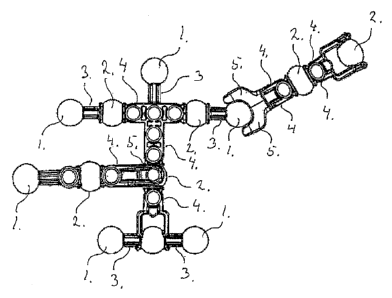Une partie des informations de ce site Web a été fournie par des sources externes. Le gouvernement du Canada n'assume aucune responsabilité concernant la précision, l'actualité ou la fiabilité des informations fournies par les sources externes. Les utilisateurs qui désirent employer cette information devraient consulter directement la source des informations. Le contenu fourni par les sources externes n'est pas assujetti aux exigences sur les langues officielles, la protection des renseignements personnels et l'accessibilité.
L'apparition de différences dans le texte et l'image des Revendications et de l'Abrégé dépend du moment auquel le document est publié. Les textes des Revendications et de l'Abrégé sont affichés :
| (12) Brevet: | (11) CA 2814318 |
|---|---|
| (54) Titre français: | ENSEMBLE DE CONSTRUCTION DE JOUET |
| (54) Titre anglais: | A TOY BUILDING SET |
| Statut: | Octroyé |
| (51) Classification internationale des brevets (CIB): |
|
|---|---|
| (72) Inventeurs : |
|
| (73) Titulaires : |
|
| (71) Demandeurs : |
|
| (74) Agent: | SMART & BIGGAR LP |
| (74) Co-agent: | |
| (45) Délivré: | 2018-07-03 |
| (86) Date de dépôt PCT: | 2011-10-20 |
| (87) Mise à la disponibilité du public: | 2012-04-26 |
| Requête d'examen: | 2016-09-15 |
| Licence disponible: | S.O. |
| (25) Langue des documents déposés: | Anglais |
| Traité de coopération en matière de brevets (PCT): | Oui |
|---|---|
| (86) Numéro de la demande PCT: | PCT/EP2011/068332 |
| (87) Numéro de publication internationale PCT: | WO2012/052509 |
| (85) Entrée nationale: | 2013-04-10 |
| (30) Données de priorité de la demande: | ||||||
|---|---|---|---|---|---|---|
|
La présente invention a trait à un ensemble de construction de jouet qui comprend un groupe d'éléments de construction, ayant chacun au moins une bille (1, 2) qui est disposée sur l'élément de construction, et laquelle bille (1, 2) est reliée à d'autres pièces de l'élément de construction par l'intermédiaire d'une tige de connexion (3, 4). Ledit ensemble de construction de jouet comprend en outre au moins un élément qui est doté d'une cavité constituée de deux mâchoires (5), qui est agencée et conçue de manière à recevoir ladite bille (1, 2) en vue de former un joint de bille et de cavité, la coupe transversale de la tige de connexion (3), à partir de laquelle se fait la liaison avec la bille (1) et au moins à une certaine distance de la bille (1), étant plus petite que la coupe transversale de la bille (1), de sorte qu'il est possible d'obtenir un certain degré de liberté permettant à la cavité de tourner autour de la bille (1). Les tiges de connexion (3, 4) comprennent également des tiges de connexion (4) qui sont dotées d'une coupe transversale relativement large, de sorte que les tiges de connexion (4) dotées d'une coupe transversale relativement large réduisent le degré de liberté permettant à la cavité de tourner autour de la bille (2).
A toy building set comprising a group of building elements, each having at least one ball 1, 2 arranged on the building element, and where the ball 1, 2 is connected to other parts of the building element via a connection rod 3, 4, and where the toy building set further comprises at least one element having a socket formed by two jaws 5, being arranged and adapted for receiving said ball 1, 2 in order to form a ball and socket joint, and where the cross section of the connection rod 3, from where it is connected to the ball 1 and at least a distance away from the ball 1, is smaller than the cross section of the ball 1, so that it gives a certain degree of freedom for the socket to rotate around the ball 1. The connection rods 3, 4 also comprise connections rods 4 having a relatively large cross section, so that the connection rods 4 with a relatively large cross section reduces the degree of freedom for the socket to rotate around the ball 2.
Note : Les revendications sont présentées dans la langue officielle dans laquelle elles ont été soumises.
Note : Les descriptions sont présentées dans la langue officielle dans laquelle elles ont été soumises.

Pour une meilleure compréhension de l'état de la demande ou brevet qui figure sur cette page, la rubrique Mise en garde , et les descriptions de Brevet , États administratifs , Taxes périodiques et Historique des paiements devraient être consultées.
| Titre | Date |
|---|---|
| Date de délivrance prévu | 2018-07-03 |
| (86) Date de dépôt PCT | 2011-10-20 |
| (87) Date de publication PCT | 2012-04-26 |
| (85) Entrée nationale | 2013-04-10 |
| Requête d'examen | 2016-09-15 |
| (45) Délivré | 2018-07-03 |
Il n'y a pas d'historique d'abandonnement
Dernier paiement au montant de 263,14 $ a été reçu le 2023-10-09
Montants des taxes pour le maintien en état à venir
| Description | Date | Montant |
|---|---|---|
| Prochain paiement si taxe générale | 2024-10-21 | 347,00 $ |
| Prochain paiement si taxe applicable aux petites entités | 2024-10-21 | 125,00 $ |
Avis : Si le paiement en totalité n'a pas été reçu au plus tard à la date indiquée, une taxe supplémentaire peut être imposée, soit une des taxes suivantes :
Les taxes sur les brevets sont ajustées au 1er janvier de chaque année. Les montants ci-dessus sont les montants actuels s'ils sont reçus au plus tard le 31 décembre de l'année en cours.
Veuillez vous référer à la page web des
taxes sur les brevets
de l'OPIC pour voir tous les montants actuels des taxes.
Les titulaires actuels et antérieures au dossier sont affichés en ordre alphabétique.
| Titulaires actuels au dossier |
|---|
| LEGO A/S |
| Titulaires antérieures au dossier |
|---|
| S.O. |